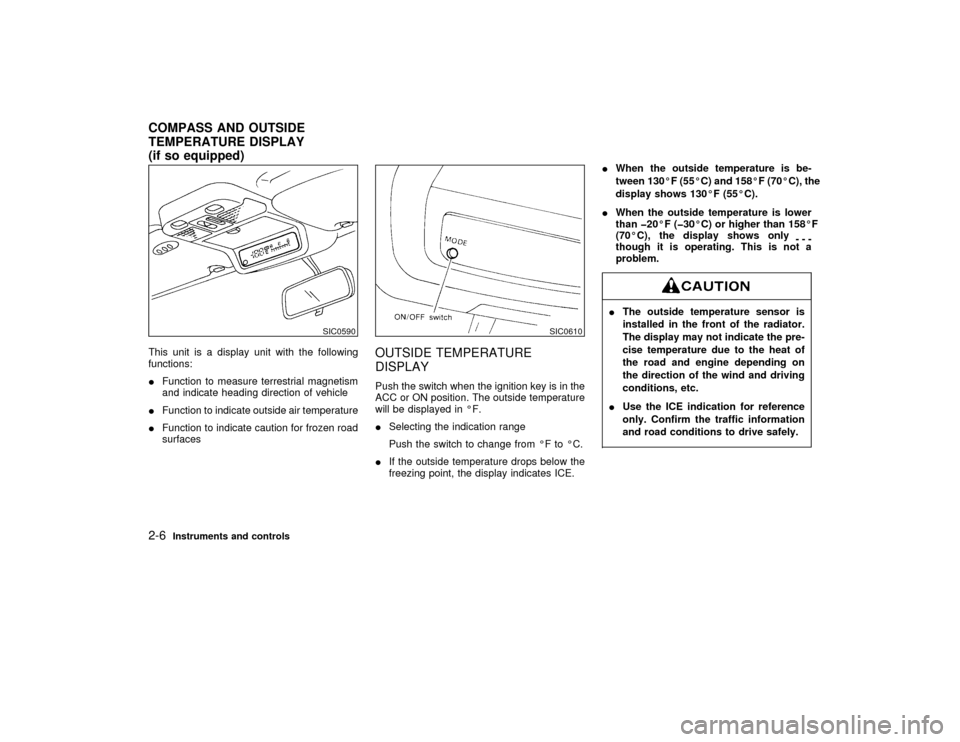key NISSAN PATHFINDER 1999 R50 / 2.G Owners Manual
[x] Cancel search | Manufacturer: NISSAN, Model Year: 1999, Model line: PATHFINDER, Model: NISSAN PATHFINDER 1999 R50 / 2.GPages: 274, PDF Size: 2.34 MB
Page 17 of 274

PRECAUTIONS ON
SUPPLEMENTAL RESTRAINT
SYSTEMThis Supplemental Restraint System (SRS)
section contains important information con-
cerning the driver and passenger supplemen-
tal air bags, supplemental side air bags and
pre-tensioner seat belts.
Supplemental air bag system:This system
can help cushion the impact force to the face
and chest of the driver and front passenger in
certain frontal collisions.
Supplemental side air bag system (if so
equipped):This system can help cushion the
impact force to the head and chest area of the
driver and front passenger in certain side
impact collisions. The supplemental side air
bags are designed to inflate on the side where
the vehicle is impacted.
These supplemental restraint systems are de-
signed tosupplementthe crash protection
provided by the driver and front passenger
seat belts and arenot a substitutefor them.
Seat belts should always be correctly worn
and the driver and front passenger seated a
suitable distance away from the steering
wheel, instrument panel and front door finish-
ers. (See ªSeat beltsº later in this section forinstructions and precautions on seat belt us-
age.)
After turning the ignition key to the ON
position, the supplemental air bag warning
light illuminates. The supplemental air bag
warning light will turn off after about 7
seconds if the systems are operational.SUPPLEMENTAL RESTRAINT
SYSTEM1-10
Seats, restraints and supplemental air bag systems
Z
01.1.22/R50-D/V5
X
Page 23 of 274

Supplemental air bag systemThe driver supplemental air bag is located in
the center of the steering wheel; the front
passenger supplemental air bag is mounted in
the dashboard above the glove box. These
systems are designed to meet optional certifi-
cation requirements under U.S. regulations.
They are also permitted in Canada. The op-
tional certification allows air bags to be de-
signed to inflate somewhat less forcefully than
previously.However, all of the information,
cautions and warnings in this manual still
apply and must be followed.The supple-
mental air bags are designed to inflate inhigher severity frontal collisions, although they
may inflate if the forces in another type of
collision are similar to those of a higher sever-
ity frontal impact. They may not inflate in
certain frontal collisions. Vehicle damage (or
lack of it) is not always an indication of proper
supplemental air bag operation.
When the supplemental air bag inflates, a fairly
loud noise may be heard, followed by release
of smoke. This smoke is not harmful and does
not indicate a fire, but care should be taken not
to inhale it, as it may cause irritation and
choking. Those with a history of a breathing
condition should get fresh air promptly.Supplemental air bags, along with the use of
seat belts, help to cushion the impact force on
the face and chest of the occupant. They can
help save lives and reduce serious injuries.
However, an inflating supplemental air bag
may cause facial abrasions or other injuries.
Supplemental air bags do not provide restraint
to the lower body.
The seat belts should be correctly worn and
the driver and passenger seated upright as far
as practical away from the steering wheel or
dashboard. Since the supplemental air bag
inflates quickly in order to help protect the
occupant, the force of the supplemental air
bag inflating can increase the risk of injury if
the occupant is too close to or is against the
supplemental air bag module during inflation.
The supplemental air bags will deflate quickly
after a collision is over.
After turning the ignition key to the ON
position, the supplemental air bag warning
light illuminates. The supplemental air bag
warning light will turn off after about 7
seconds if the system is operational.
IDo not place any objects on the steer-
ing wheel pad or on the instrument
SSS0138
1-16
Seats, restraints and supplemental air bag systems
Z
01.1.22/R50-D/V5
X
Page 25 of 274

the driver and passenger seated upright as far
as practical away from the supplemental side
air bags. Since the supplemental side air bags
inflate quickly in order to help protect the front
occupants, the force of the supplemental side
air bag inflating can increase the risk of injury
if the occupant is too close to or is against the
supplemental side air bag module during infla-
tion. The supplemental side air bags will de-
flate quickly after the collision is over.
After turning the ignition key to the ON
position, the supplemental air bag warning
light illuminates. The supplemental air bag
warning light will turn off after about 7
seconds if the system is operational.IDo not place any objects near the
seatback of the front seats. Also, do
not place any objects (an umbrella,
bag, etc.) between the front door fin-
isher and the front seat. Such objects
may become dangerous projectiles
and cause injury if the supplemental
side air bags inflate.
IRight after inflation, several supple-
mental side air bag system compo-nents will be hot. Do not touch them;
you may severely burn yourself.
INo unauthorized changes should be
made to any components or wiring of
the supplemental side air bag sys-
tem. This is to prevent accidental
inflation of the supplemental side air
bags or damage to the supplemental
side air bag system.
IDo not make unauthorized changes
to your vehicle's electrical system,
suspension system or side panel.
This could affect proper operation of
the supplemental side air bag sys-
tem.
ITampering with these supplemental
system may result in serious per-
sonal injury. Tampering includes
changes to the front seats assembly
by placing material near the seatback
of the front seat, or by installing ad-
ditional trim material around the
supplemental side air bag system.
IWork around and on the supplemen-
tal side air bag system should be
done by an authorized NISSANdealer. Installation of electrical equip-
ment should also be done by an au-
thorized NISSAN dealer. The SRS wir-
ing harnesses* should not be
modified or disconnected. Unautho-
rized electrical test equipment and
probing devices should not be used
on the supplemental side air bag sys-
tem.
* The SRS wiring harnesses are cov-
ered with yellow insulation either just
before the harness connectors or
over the complete harness for easy
identification.
When selling your vehicle, we request that you
inform the buyer about the supplemental side
air bag system and guide the buyer to the
appropriate sections in this Owner's Manual.Pre-tensioner seat belt system (if so
equipped for front seats)IThe pre-tensioner seat belts cannot
be reused after activation. They must
1-18
Seats, restraints and supplemental air bag systems
Z
01.1.22/R50-D/V5
X
Page 26 of 274

be replaced together with the retrac-
tor as a unit.
IIf the vehicle becomes involved in a
frontal collision but the pre-tensioner
is not activated, be sure to have the
pre-tensioner system checked and, if
necessary, replaced by your NISSAN
dealer.
INo unauthorized changes should be
made to any components or wiring of
the pre-tensioner seat belt system.
This is to prevent accidental activa-
tion of the pre-tensioner seat belts or
damage to the pre-tensioner seat belt
operation. Tampering with the pre-
tensioner seat belt system may result
in serious personal injury.
IWork around and on the pretensioner
system should be done by an autho-
rized NISSAN dealer. Installation of
electrical equipment should also be
done by an authorized NISSAN
dealer. Unauthorized electrical test
equipment and probing devices
should not be used on the pre-
tensioner seat belt system.IIf you need to dispose of the pre-
tensioner or scrap the vehicle, con-
tact an authorized NISSAN dealer.
Correct pre-tensioner disposal proce-
dures are set forth in the appropriate
NISSAN Service Manual. Incorrect
disposal procedures could cause
personal injury.
The front seat pre-tensioner seat belt system
activates in conjunction with the supplemental
air bags. Working with the seat belt retractor, it
helps tighten the seat belt the instant the
vehicle becomes involved in certain types of
collisions, thereby restraining seat occupants.
The pre-tensioner is encased with the seat
belt's retractor. These seat belts are used the
same as conventional seat belts.
When the pre-tensioner seat belt activates,
smoke is released and a loud noise may be
heard. The smoke is not harmful, but care
should be taken not to inhale it as it may cause
irritation and choking.
If any abnormality occurs in the pre-tensioner
system, the seat belt warning light
will
flash intermittently after the ignition key is
turned to the ON or START position. In this
case, the pre-tensioner seat belt will not func-tion properly. The system should be inspected
by an authorized NISSAN dealer.
When selling your vehicle, we request that you
inform the buyer about the pre-tensioner seat
belt system and guide the buyer to the appro-
priate sections in this Owner's Manual.
Seats, restraints and supplemental air bag systems
1-19
Z
01.1.22/R50-D/V5
X
Page 27 of 274

SUPPLEMENTAL AIR BAG
WARNING LABELSWarning labels about the supplemental air bag
system and supplemental side air bag system
are placed in the vehicle.
SUPPLEMENTAL AIR BAG
WARNING LIGHTThe supplemental air bag warning light, dis-
playing AIR BAG in the instrument panel,
monitors the circuits of the supplemental air
bag and supplemental side air bag systems.
The circuits monitored by the supplemental air
bag warning light are the diagnosis sensor
unit, satellite sensors, supplemental air bag
modules, supplemental side air bag modules
and all related wiring.
After turning the ignition key to the ON posi-
tion, the air bag warning light illuminates. The
supplemental air bag warning light will turn off
SSS0139
SPA0652
1-20
Seats, restraints and supplemental air bag systems
Z
01.1.22/R50-D/V5
X
Page 28 of 274

after about 7 seconds if the systems are
operational.
If any of the following conditions occurs, the
supplemental air bag and supplemental side
air bag systems need servicing:
IThe supplemental air bag warning light
does not come on and remain on for 7
seconds and then go off as described
above.
IThe supplemental air bag warning light
flashes intermittently or remains on (after 7
seconds).
IThe supplemental air bag warning light
does not come on at all.
Under these conditions, the supplemental air
bags or supplemental side air bags may not
operate properly. It must be checked and
repaired. Take your vehicle to the nearest
authorized NISSAN dealer.If the supplemental air bag warning light
is on, it could mean that the supplemen-
tal air bag system or supplemental side
air bag system will not operate in an
accident.
Repair and replacement procedureThe supplemental air bags and supplemental
side air bags are designed to inflate on a
one-time-only basis. As a reminder, unless
they are damaged, the supplemental air bag
warning light will remain illuminated after infla-
tion has occurred. Repair and replacement of
the supplemental systems should be done
only by authorized NISSAN dealers.
To ensure long-term functioning, the sys-
tems must be inspected 10 years after the
date of manufacture noted on the certifica-
tion label located on the driver side center
pillar.
When maintenance work is required on the
vehicle, the supplemental systems and related
parts should be pointed out to the person
conducting the maintenance. The ignition key
should always be in the LOCK position when
working under the hood or inside the vehicle.IOnce the supplemental air bags or
supplemental side air bags have in-
flated, these supplemental modules
will not function again and must be
replaced. The supplemental air bagmodules or supplemental side air bag
modules should be replaced by an
authorized NISSAN dealer. These
supplemental modules cannot be re-
paired.
IThe supplemental air bag and supple-
mental side air bag systems should
be inspected by an authorized
NISSAN dealer if there is any damage
to the front end portion of the vehicle.
IIf you need to dispose of these
supplemental systems or scrap the
vehicle, contact an authorized
NISSAN dealer. Correct disposal pro-
cedures are set forth in the appropri-
ate NISSAN Service Manual. Incorrect
disposal procedures could cause
personal injury.
Seats, restraints and supplemental air bag systems
1-21
Z
01.1.22/R50-D/V5
X
Page 56 of 274

SPEEDOMETER AND ODOMETER
SpeedometerThe speedometer indicates vehicle speed.Odometer/twin trip odometerThe odometer/twin trip odometer are displayed
when the ignition key is in the ON position.
The odometer records the total distance the
vehicle has been driven.
The twin trip odometer records the distance of
individual trips.
SIC0857
SIC0858
METERS AND GAUGES
Instruments and controls
2-3
Z
01.1.22/R50-D/V5
X
Page 58 of 274

the engine is overheated, continued op-
eration of the vehicle may seriously
damage the engine. See ªIf your vehicle
overheatsº in the ª6. In case of emer-
gencyº section for immediate action
required.
FUEL GAUGEThe gauge indicates the APPROXIMATE fuel
level in the tank.
The gauge may move slightly during braking,
turning, acceleration, or going up or down hill.
The gauge needle is designed to remain in
approximately the same position, even when
the ignition key is turned OFF.
Refill the fuel tank before the gauge regis-
ters Empty.
The indicator light comes on when the fuel
tank is getting low. Refuel as soon as it isconvenient, preferably before the gauge
reaches E. There will be a small reserve of
fuel in the tank when the fuel gauge needle
reaches E.
If the vehicle is driven with the fuel level
very low, the malfunction indicator light
may come on. Refuel as soon as pos-
sible. After re-fueling, the light should
go off. If the light remains on, have the
vehicle inspected by an authorized
NISSAN dealer.
For additional information, see the ªMal-
function indicator light (MIL)º later in
this section.
SIC0960
Instruments and controls
2-5
Z
01.1.22/R50-D/V5
X
Page 59 of 274

This unit is a display unit with the following
functions:
IFunction to measure terrestrial magnetism
and indicate heading direction of vehicle
IFunction to indicate outside air temperature
IFunction to indicate caution for frozen road
surfaces
OUTSIDE TEMPERATURE
DISPLAYPush the switch when the ignition key is in the
ACC or ON position. The outside temperature
will be displayed in ÉF.
ISelecting the indication range
Push the switch to change from ÉF to ÉC.
IIf the outside temperature drops below the
freezing point, the display indicates ICE.IWhen the outside temperature is be-
tween 130ÉF (55ÉC) and 158ÉF (70ÉC), the
display shows 130ÉF (55ÉC).
IWhen the outside temperature is lower
than þ20ÉF (þ30ÉC) or higher than 158ÉF
(70ÉC), the display shows only
---
though it is operating. This is not a
problem.
IThe outside temperature sensor is
installed in the front of the radiator.
The display may not indicate the pre-
cise temperature due to the heat of
the road and engine depending on
the direction of the wind and driving
conditions, etc.
IUse the ICE indication for reference
only. Confirm the traffic information
and road conditions to drive safely.
SIC0590
SIC0610
COMPASS AND OUTSIDE
TEMPERATURE DISPLAY
(if so equipped)2-6
Instruments and controls
Z
01.1.22/R50-D/V5
X
Page 60 of 274

COMPASS DISPLAYPush the switch when the ignition key is in the
ACC or ON position. The direction will be
displayed.Zone variation change procedureThe difference between magnetic north and
geographical north is known as variance. In
some areas, this difference can sometimes be
great enough to cause false compass read-
ings. Follow these instructions to set the vari-
ance for your particular location if this hap-
pens:
1. Establish your location on the zone map.
Record your zone number.
2. Push the ON/OFF switch in for five seconds
until the current zone entry number is dis-
played.
3. Press the ON/OFF switch repeatedly until
the new zone entry number is displayed.
Once the desired zone number is displayed,
stop pressing the ON/OFF switch and the
display will show compass direction within a
few seconds.
SIC0611
Instruments and controls
2-7
Z
01.1.22/R50-D/V5
X